North Carolina is a hotbed when it comes to animal life. It has an abundance of species, from the common house mouse to the majestic bald eagle, and even a few species that are only found here in the state.
And one of the things that often surprises people is just how many turtle species there are here!
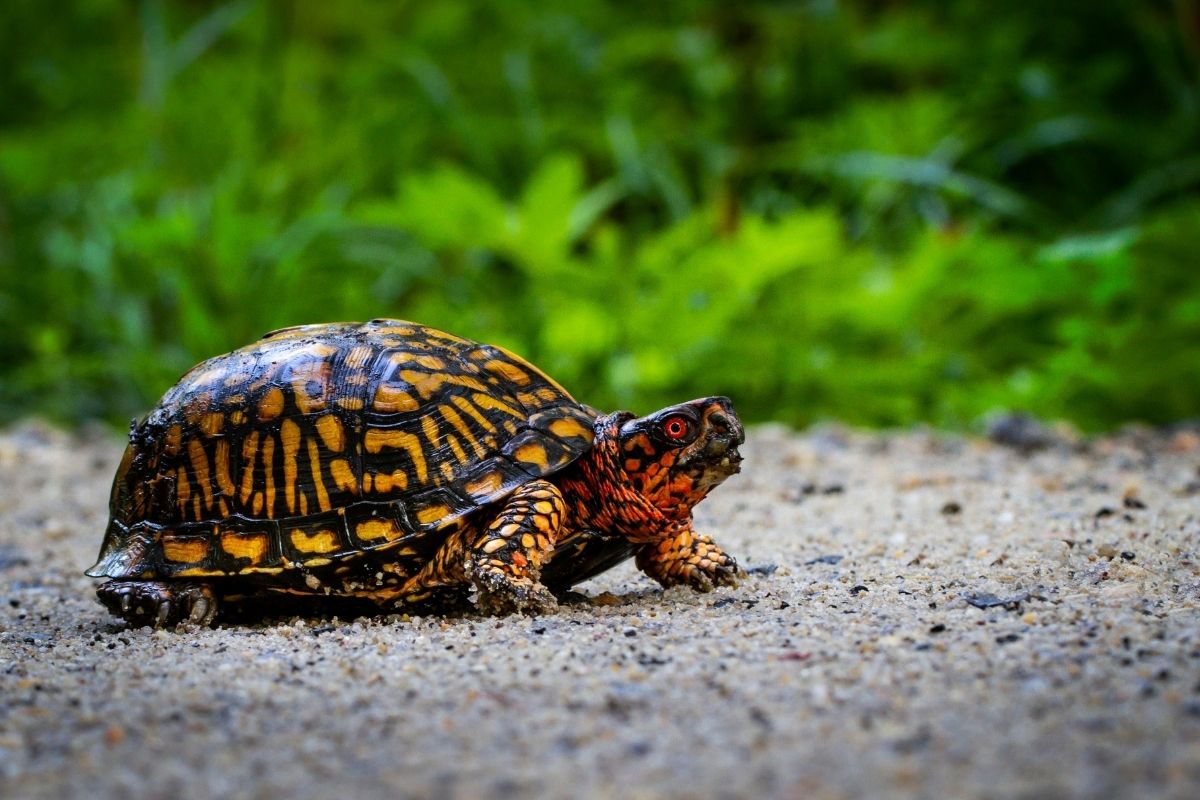
There are well over a dozen well-known types of turtles you can find in North Carolina, from the tiniest terrapin all the way up to some of the largest species of reptiles in the world.
Each type of turtle has its unique characteristics and habitats, which makes finding them very interesting indeed. So let’s take a look at the 21 different types of turtles you can see in North Carolina!
Bog Turtle
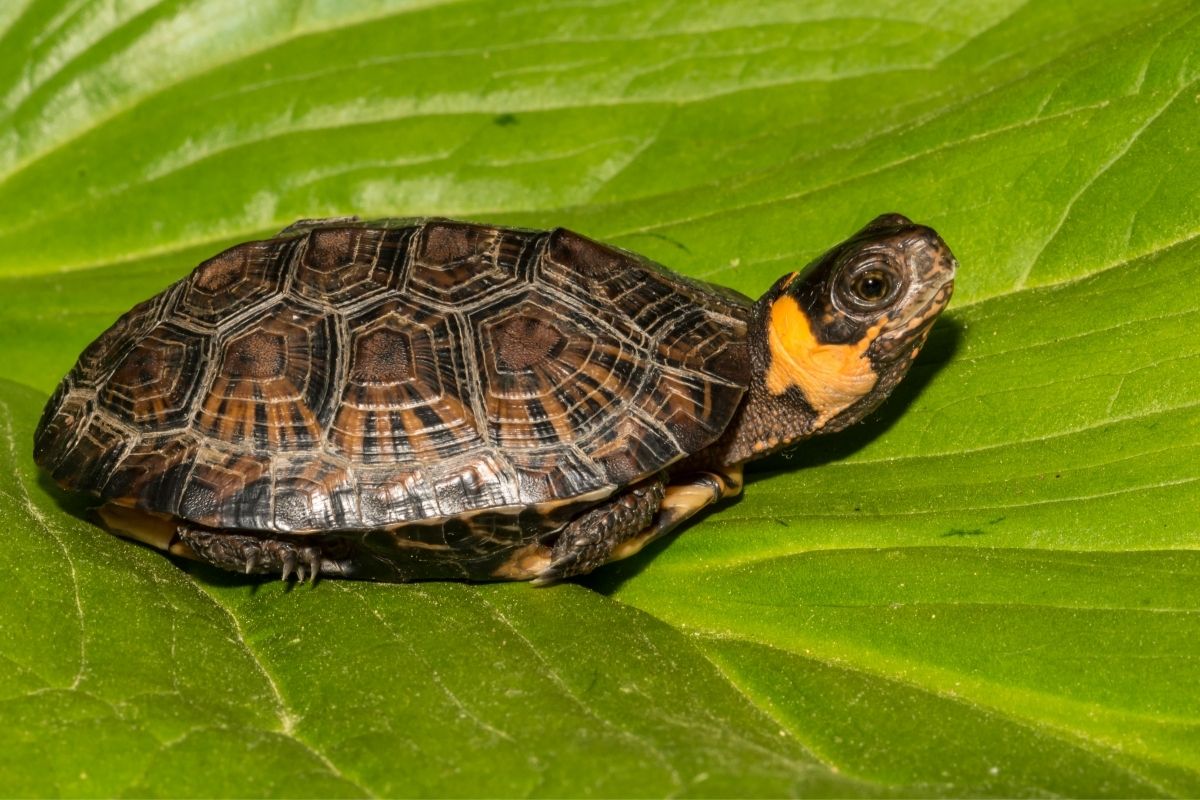
Starting off this list of North Carolina turtles with one of its smallest, we have the little Bog turtle.
These tiny turtles are amongst the smallest in all of North America, barely growing to a little over 3.5 inches long. The biggest bog turtles only ever grow as large as 5 inches, if that!
The Bog Turtle is found throughout most of North Carolina and can be found from the coast up into the mountains.
They live in freshwater streams, ponds, and lakes, although, as their name suggests, they are most often found in and around swamps and bogs.
They nest in damp areas such as near waterfalls or creeks, so they’re often seen lurking around these sites.
Unlike other turtles, the Bog Turtle doesn’t dig nests, but instead just lays eggs in the soft mud at the bottom of their habitat.
This makes them much more difficult for people to find than many other turtles because it means there aren’t any tracks leading away from where they make their homes.
If you come across a Bog Turtle, don’t worry – they tend to be very shy animals, unlike many other turtle species, which are known for their hostility and aggressive response.
If you want to pet one, then give it some time, and it will generally approach you. It’s not uncommon to see them waddling towards you on land, especially when they feel like being caught by humans isn’t going to happen anytime soon.
Unfortunately, this species of turtle is also critically endangered, with the habitats and territories that it usually inhabits being threatened by many invasive species of flora and fauna.
It has been estimated that up to 80% of the natural colonies have been lost in the last 30 years thanks to a combination of pollution, pesticides, and industrial discharge.
Common Snapping Turtle
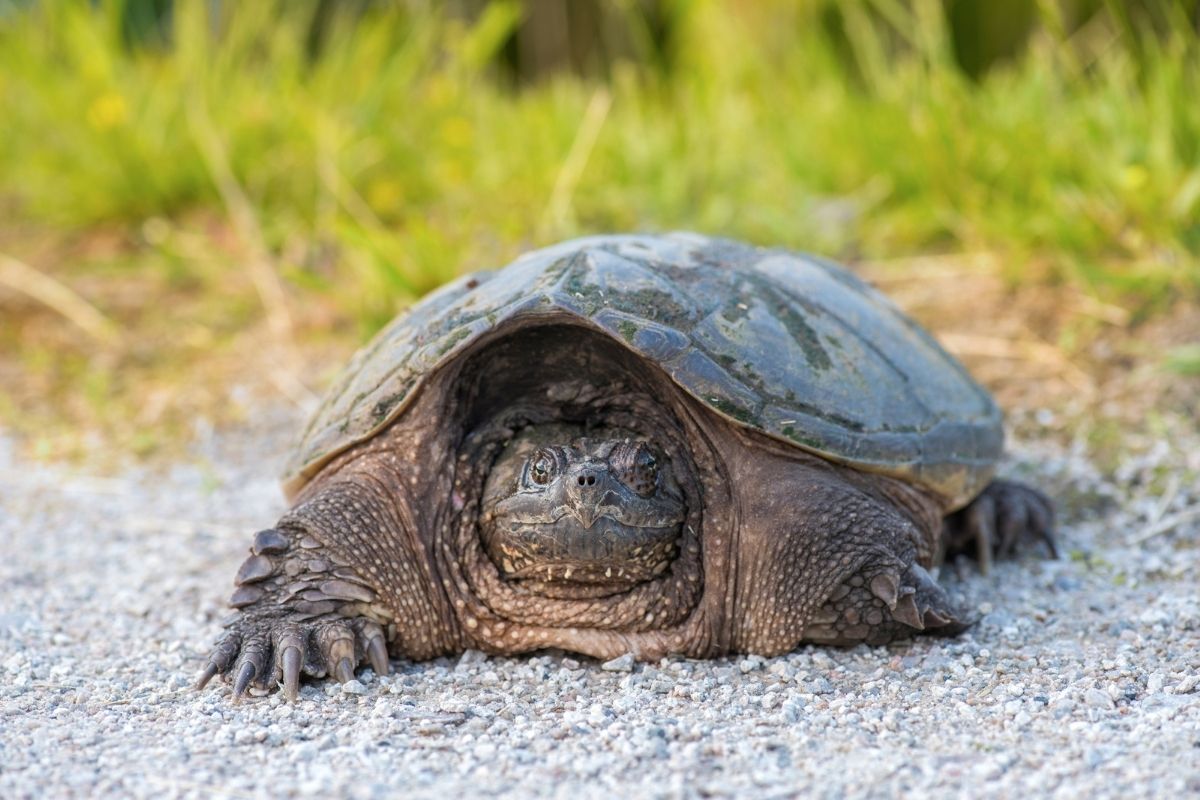
From the smallest species to one of the largest, the common snapping turtle is a very common sight across the Eastern and Central United States, from the Rockies all the way to the Eastern Seaboard.
Snapping turtles are easily recognized by their flat shells, and they’re commonly referred to as ‘alligator turtles’ due to the similarity between the shape of their shell and an alligator’s skin.
While it’s true that the shell does look similar to the skin of an alligator, the term ‘snapper’ comes from the fact that these turtles have large, powerful jaws that snap shut in the blink of an eye.
These turtles are carnivores and feed primarily on fish. However, they occasionally eat smaller reptiles, amphibians, and even small mammals.
Due to their size, they are often mistaken for lizards but can be identified by the presence of three rows of teeth along their upper jawline.
A few individuals have been documented eating frogs and salamanders, although this behavior is rare.
These turtles have a lifespan of usually 40 years and reach sexual maturity around 15 to 20 years old. In warmer climates, they may breed year-round, whereas in colder regions, breeding takes place during the winter months.
And they are a surprisingly northern reptile species, as there are plenty of turtle colonies found across both the Northern United States and Canada.
Due to their broad distribution and widespread popularity, the common snapping turtle has gone through several conservation efforts in recent decades.
Unfortunately, many of these efforts have failed, and the populations continue to decline. Habitat loss continues to be a major problem, with much of the area inhabited by these turtles becoming developed over the past century.
Eastern Box Turtle
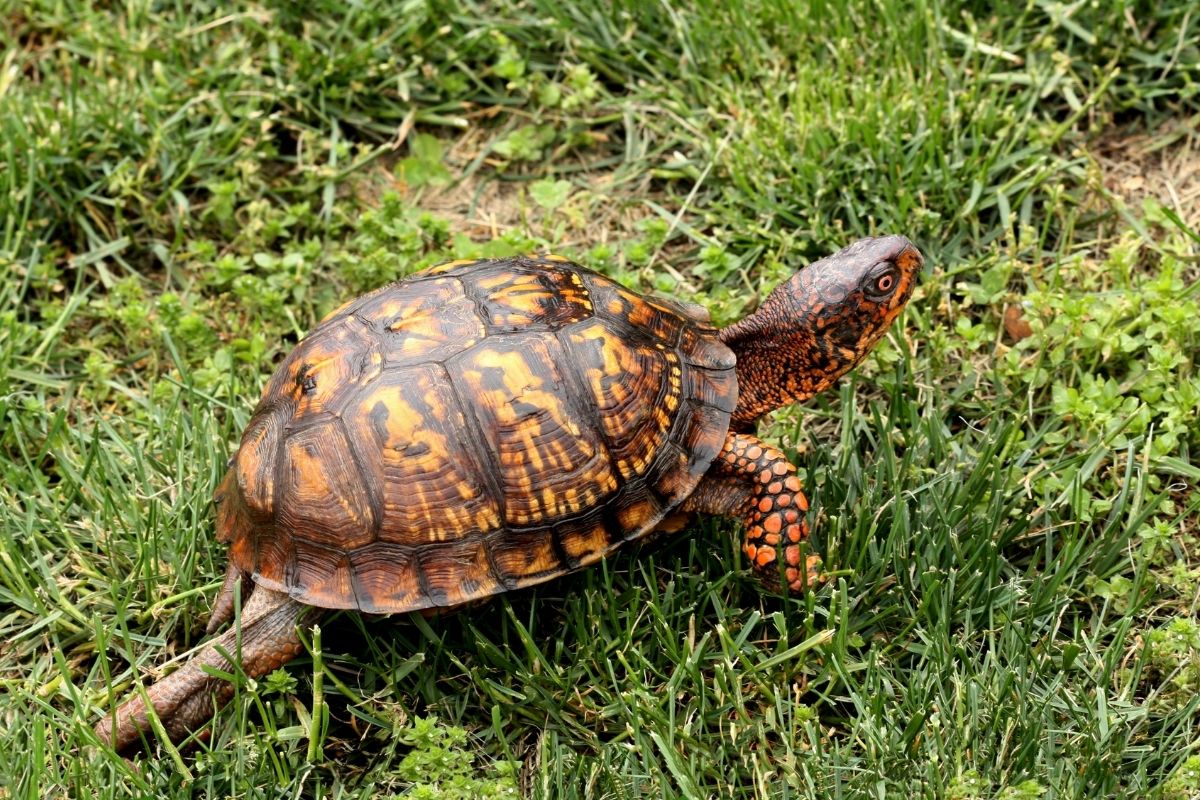
Another common species that are found all across the United States, Eastern Box turtles are most often found in the Eastern States, such as North and South Carolina.
Box turtles are average to smaller-sized turtles, usually growing somewhere in the range of 4 to 7 inches long.
They are a high-domed species, meaning that their shells have a very tall and rounded tops to them, especially when compared to many other turtles and terrapins.
The box turtle has a lifespan of typically 50 to 60 years, though some have lived longer than 100 years. Like many other turtles, they reach sexual maturity at about 5 years of age.
While the box turtle population isn’t as dramatically declining as the bog turtle, it is still facing several problems.
Many areas where these turtles live are being built up to support human habitation. This habitat destruction means that food becomes harder to find, which leads to more competition.
This species is also very popular for exotic pet owners to have as a companion.
While box turtles are capable of living without food for extended periods, they require regular access to water at least once per day to stay hydrated and healthy.
They prefer to live in moist conditions, so if your home doesn’t contain any water, they won’t be happy about it. Make sure you provide them with enough space and ample opportunities to get fresh water.
One interesting thing about box turtles is that they lay eggs at different times throughout the year.
Females usually start laying eggs around March and then will generally stop laying until late August. The average hatchling emerges from the egg approximately 70 days later.
Painted Turtle
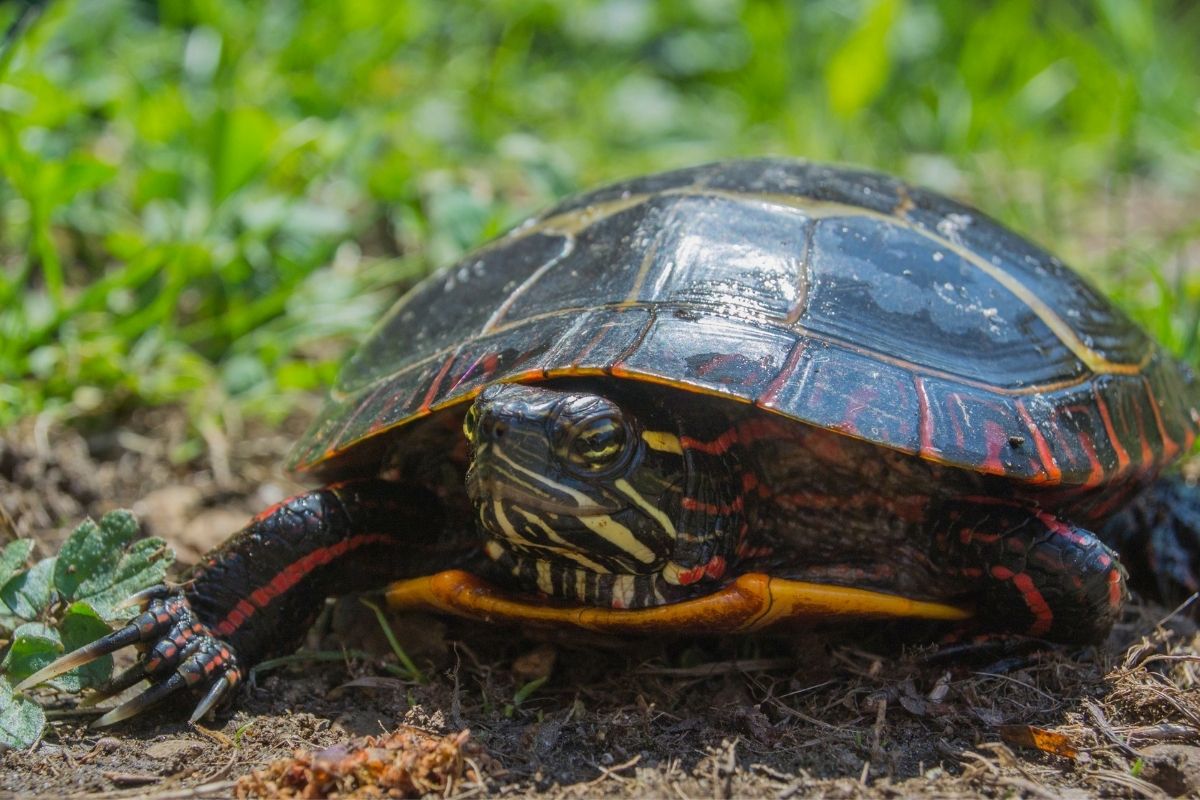
Up next on this list, we have the Painted Turtle.
Known for its beautiful striped patterns that come in a variety of shades of greens, yellows, and oranges, this species is another widely-distributed reptile, being found in the many Eastern States such as Illinois, Michigan, and, of course, North Carolina.
While not as widely distributed across the country as its cousins, it is still fairly abundant. Their natural habitats include ponds and creeks, so they tend to avoid coastal areas due to saltwater intrusion.
Like the Eastern Box Turtle, the painted turtle has a lifespan ranging anywhere from 30 to 70 years.
Unlike the box turtle, it reaches sexual maturation at a younger age, usually between 8 and 10 years. Males mature faster than females, reaching full growth a year or two before the females.
Thanks to its popularity as a pet, trying to determine the Painted turtle’s natural range in the United States is difficult, as many owners will often release their turtles into the wild, or they will even escape, making it very difficult to get accurate readings on how well wild populations are faring.
One of the biggest threats to the wild Painted turtle population is pollution. Some pollutants can cause deformities in the developing embryos, causing the body shape and size of the baby turtles to change drastically.
Other sources of pollution may impact the turtle’s overall health, interfering with digestion or leading to respiratory issues.
These turtles are omnivores, eating small insects and plants along with fruit, vegetables, fish, frogs, crayfish, and crabs.
It is believed that they can even eat earthworms. They do not consume meat unless it is dead but will eat carrion. As mentioned above, they need access to fresh water at least once per week, preferably twice.
Eastern Chicken Turtle
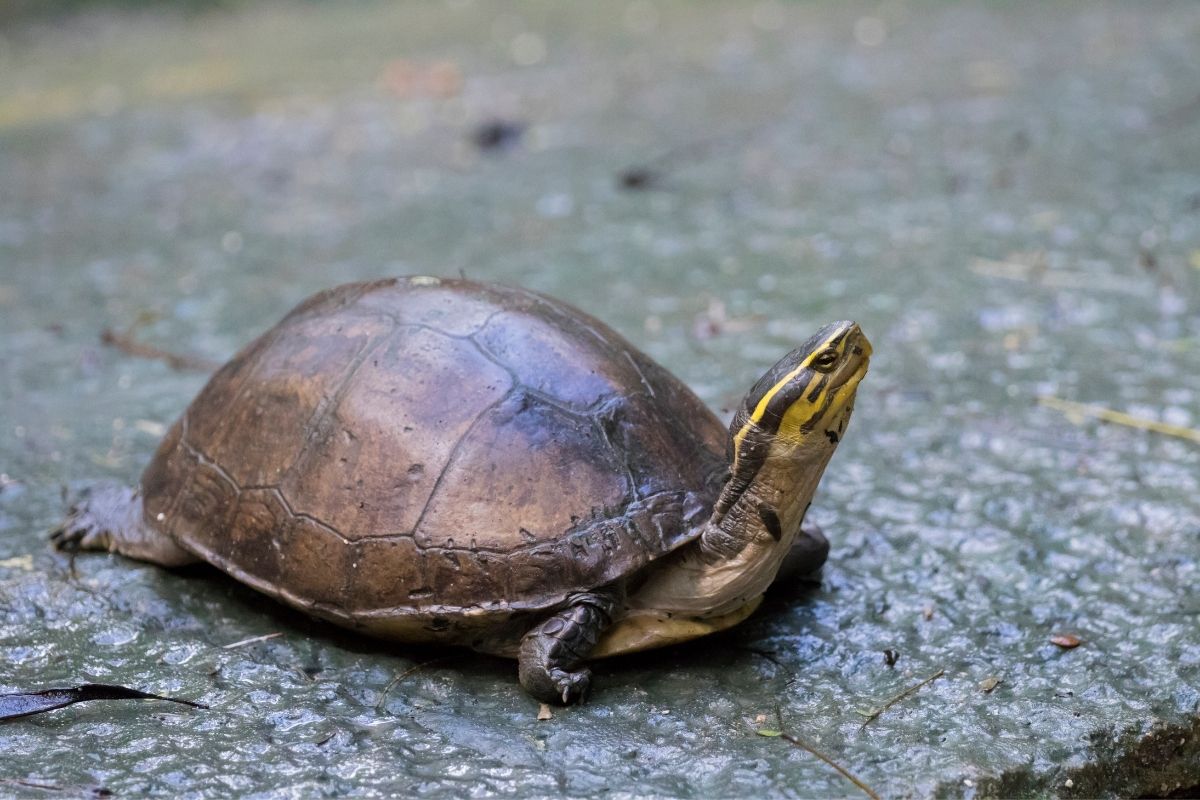
The Eastern chicken turtle was first discovered by Europeans during colonial America, and now it lives in every state east of the Mississippi River.
Its name comes from its bright red coloration and resemblance to an African green turtle, which is why it’s sometimes called the Red-bellied Sea Turtle.
This species is native to the Atlantic coast of the United States, though some populations have been spotted further inland. They prefer sandy beaches, where they burrow under dunes.
Unlike most other turtle species, the eastern chicken turtle does not hibernate.
During the winter months, these reptiles become sluggish, but they remain active. During springtime, they begin to prepare for the mating season.
In terms of age, Eastern Chicken turtles usually live between 15 and 30 years in the wild, with them reaching sexual maturity after a few years.
Female eastern chickens take longer to reach reproductive maturity than males, a similar pattern that is found across many different species of turtles and terrapins.
As with all turtles, these animals need plenty of fresh air and water in their habitats and a clean environment.
A common cause of mortality in this species is road traffic accidents. When cars hit turtles, they typically die from internal injuries. The best way to avoid any accidental deaths is to keep your pets off the roads.
This species has also experienced a significant decline in population due to habitat loss.
Habitat destruction includes things like the construction of highways, the development of golf courses, coastal real estate purchases, and other human activities that destroy wetlands, woodlands, and forests.
Diamond-Backed Terrapin
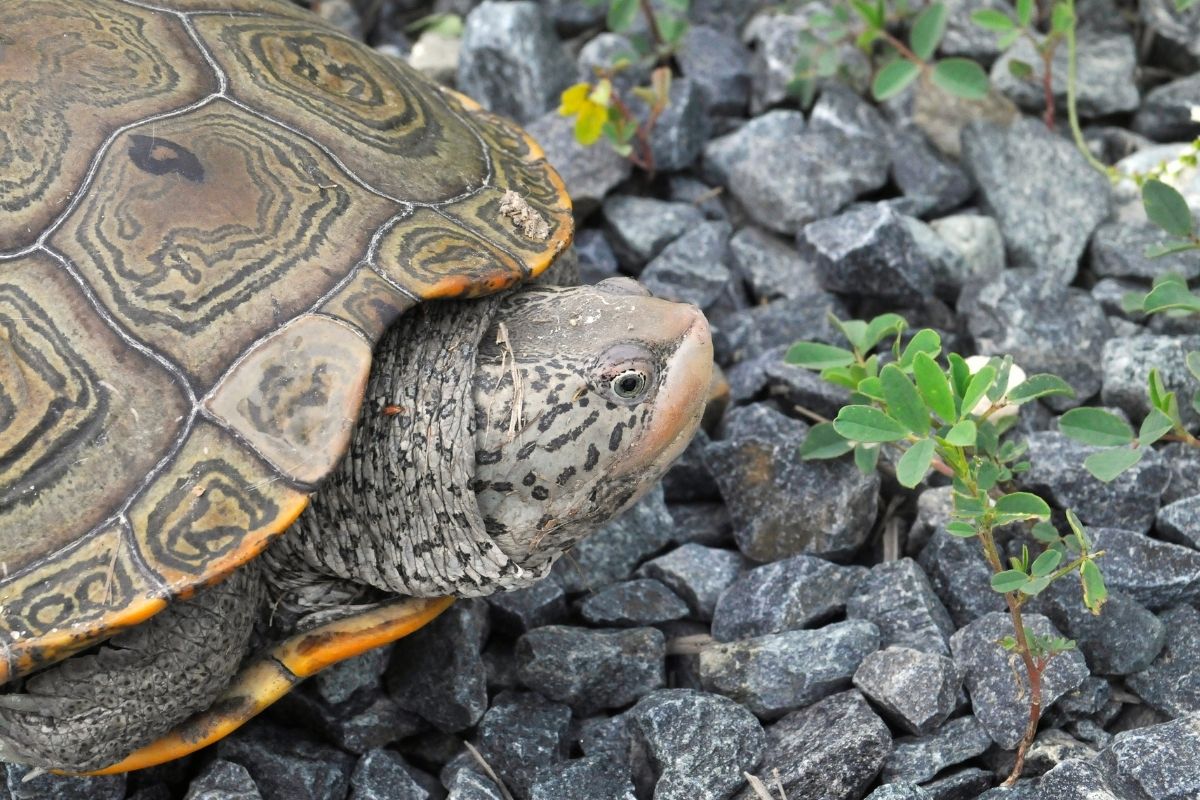
Perhaps one of the most distinct-looking small turtles on this list, the Diamond-Backed Terrapin is best known for the signature black diamond pattern on its shell.
These turtles live throughout the southeastern states, including Florida and the states of Carolina, especially near rivers and streams.
Their diet consists primarily of aquatic invertebrates such as freshwater shrimp and crustaceans. The male terrapins tend to be larger than the females.
Terrapins can survive in a wide variety of habitats and are excellent swimmers.
They are one of the few species of freshwater turtles that can survive quite well in saltwater, which makes them very adaptable to living in both freshwater lakes and rivers, as well as swamps and coastline areas where fresh and saltwater intermingle.
However, they don’t fare very well when temperatures go outside the ideal range of 60-80 degrees Fahrenheit. When exposed to extreme heat, cold, or drought, terrapins tend to lay fewer eggs, die prematurely, or both.
Like many other sea turtles, the diamond-backed terrapin has adapted to living in saltwater rather than freshwater, although they still prefer coastal areas over rivers and ponds. But unlike the majority of other turtles, they only come ashore to nest.
Females normally deposit between 15 and 30 eggs each year (and sometimes up to 100), depending on the temperature of the water.
Once the babies hatch, they look like miniature terrapins and should be released within 24 hours of hatching.
Eastern River Cooter

The river cooter’s name comes from the shape of the carapace, which resembles a scooter.
This species lives in southern states, mainly in Florida and North Carolina, where they inhabit rivers and marshes.
They eat mostly insects but also some plant material. Like other river turtles, this animal spends most of its life underwater, although it will occasionally have to surface to breathe.
It takes about 20 years for an adult river cooter to develop fully mature shells.
As with most turtle species, reproduction is highly seasonal. Males will leave the area during winter to mate with females in spring.
After mating, females return to their territory while the males remain there to guard their nests until the eggs hatch.
Male river cooters are not territorial towards other males. Most of the guarding occur at night and is done by just sitting on top of the nesting female.
Like other river turtles, the eastern river cooter has declined substantially because of habitat loss.
Habitat destruction includes things like the building of power plants, sewage treatment facilities, and other types of pollution.
This species needs lots of open space around its habitat, preferably filled with vegetation and plenty of fresh running water to swim in.
Their lifespan varies widely, but most individuals do not live beyond ten years.
Female turtles lay around 20 eggs per year during the summer months and will generally incubate them for about 80 days before the baby turtles emerge.
After emerging, the young turtles must make their way back into the rivers that they are buried near to continue their lives.
Florida Cooter
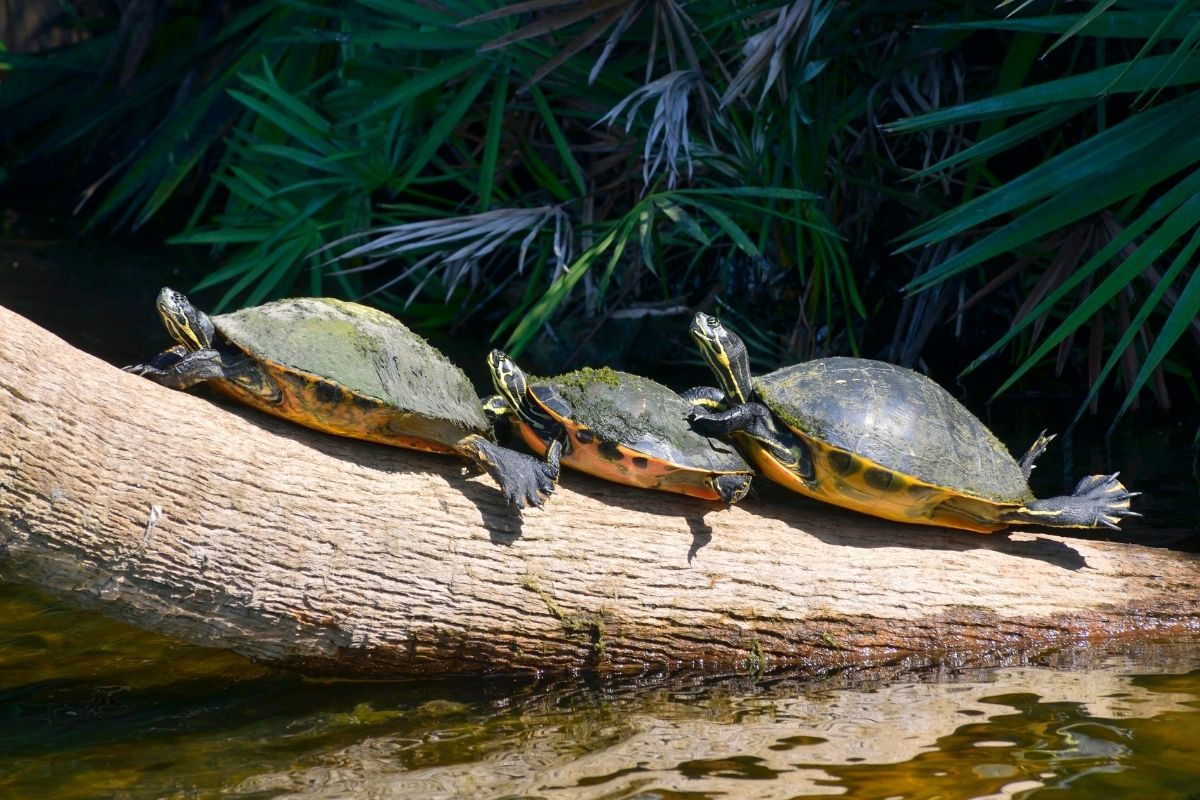
This turtle is commonly called the “Cooter,” as the name suggests, and is usually found across Florida.
However, it is also found in many states across the Eastern United States, such as North Carolina. It lives in the Florida Keys and is found in shallow waters.
While they are active throughout the day, they spend most of their time hidden under logs and debris. In addition, these animals have been known to bury themselves in sandbanks during low tide.
This species does not hibernate but instead goes through periods of dormancy. During times of low food supply, the adults will burrow down into the soil and stay there, coming out periodically to feed.
When food is plentiful, and the weather is warm enough, these turtles may raise their heads above ground to bask in the sun.
The Florida cooter’s diet consists mainly of small invertebrates, including crabs, shrimp, crayfish, snails, worms, insect larvae, and mollusks.
These creatures need to have clear water flowing nearby and good-quality vegetation to hide in.
The best places to find them are along shorelines or streams. Since they don’t hibernate, they are much more likely to be seen when the temperature is warmer than usual.
These turtles are very popular traded animals, both as pets, as well as for consumption as food.
Northern Red-Bellied Cooter
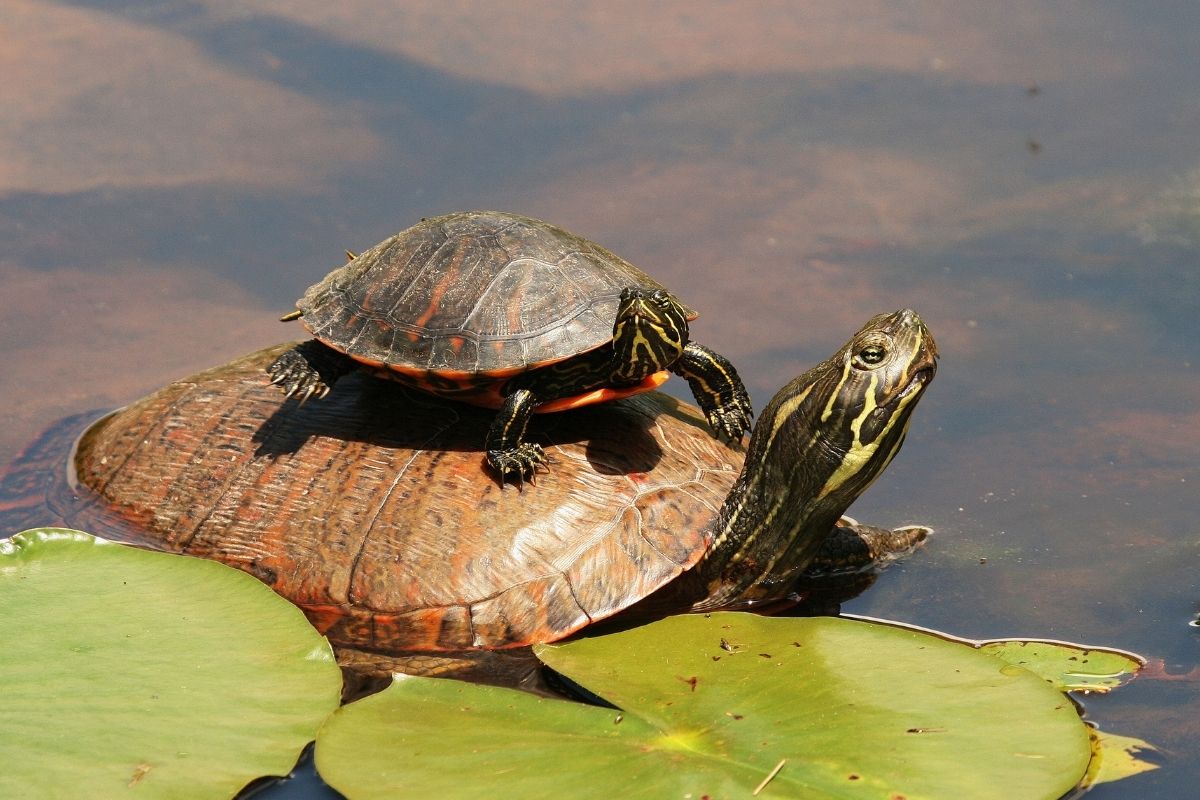
Known for their trademark red patterning on the underside of their shells, northern red-bellied cooters are native to the Southeastern United States.
They are found from Georgia northward up to Michigan’s Upper Peninsula. Their range extends further west, reaching Missouri and Oklahoma, as well as through South and North Carolina.
These reptiles can grow to be over a foot long, although this is somewhat of a rarity.
The average lifespan of this species is about 30 years, although some individuals have lived up to 60 years. Females produce multiple clutches of eggs each spring; however, only one clutch will likely ever hatch.
Once the eggs start hatching, the mothers will carry their babies in their mouths for protection. They will not stay with their parents and will usually make their way to the closest source of water once they have hatched.
As far as pets go, Northern Red-Bellied Cooters are some of the larger species that are kept as a pet and require plenty of space in their water tank to live happy and healthy lives.
Although they are not as aggressive as others, like snapping turtles, they still need to be fed regularly.
This species is considered easy to care for, but if you want to keep them, you should provide them with an aquarium of at least 40 gallons in size.
There are numerous foods available to keep your cooters healthy, including pieces of fish flakes, brine shrimp, and meaty bones, as well as some vegetarian options such as turtle feed.
Pond Slider
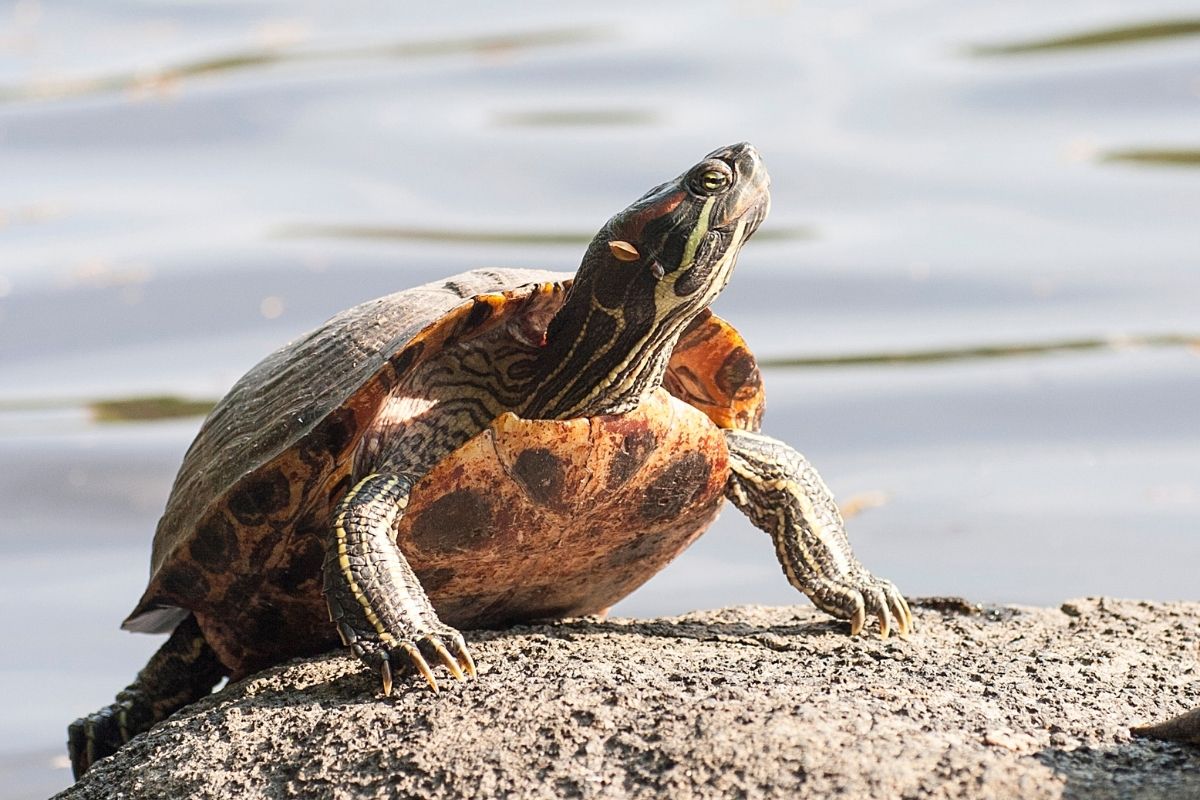
A pond slider is another common species of freshwater reptile that lives in North Carolina. This particular turtle has a unique characteristic that distinguishes it from other aquatic species: its tail is longer than its body.
If you look closely at a pond slider, you’ll notice that its tail is curled around behind its body. As the name implies, this creature spends its life moving around ponds and lakes, looking for food and shelter.
Like other turtles, pond sliders do not hibernate, so they are active year-round. They eat insects, crayfish, frogs, and other small prey items while using their large claws to dig up plants and roots.
They are omnivorous, meaning that they consume both plant matter and animal meat, including fish, mollusks of all kinds, and plenty of plant matter that exists in their habitat.
These turtles love habitats that are full of trees and plants that allow them to bask in the sun.
The best time to breed these animals is during the spring months. After mating occurs, females lay their eggs between April and June.
Once the eggs have been laid, the female will continue to guard them until they hatch. She will also protect them by carrying them in her mouth for safety.
Like most turtles, pond sliders can live for several decades, upwards of 50 years old. In terms of caring for these turtles, it is important to provide them with an adequate amount of space in which to swim around.
Since pond sliders are cold-blooded, you’ll need to ensure that their temperature remains above 80 degrees Fahrenheit.
Also, they must have access to fresh water at all times. Your pond slider needs to be provided with a varied diet consisting of various types of vegetation and animal protein sources.
Eastern Mud Turtle
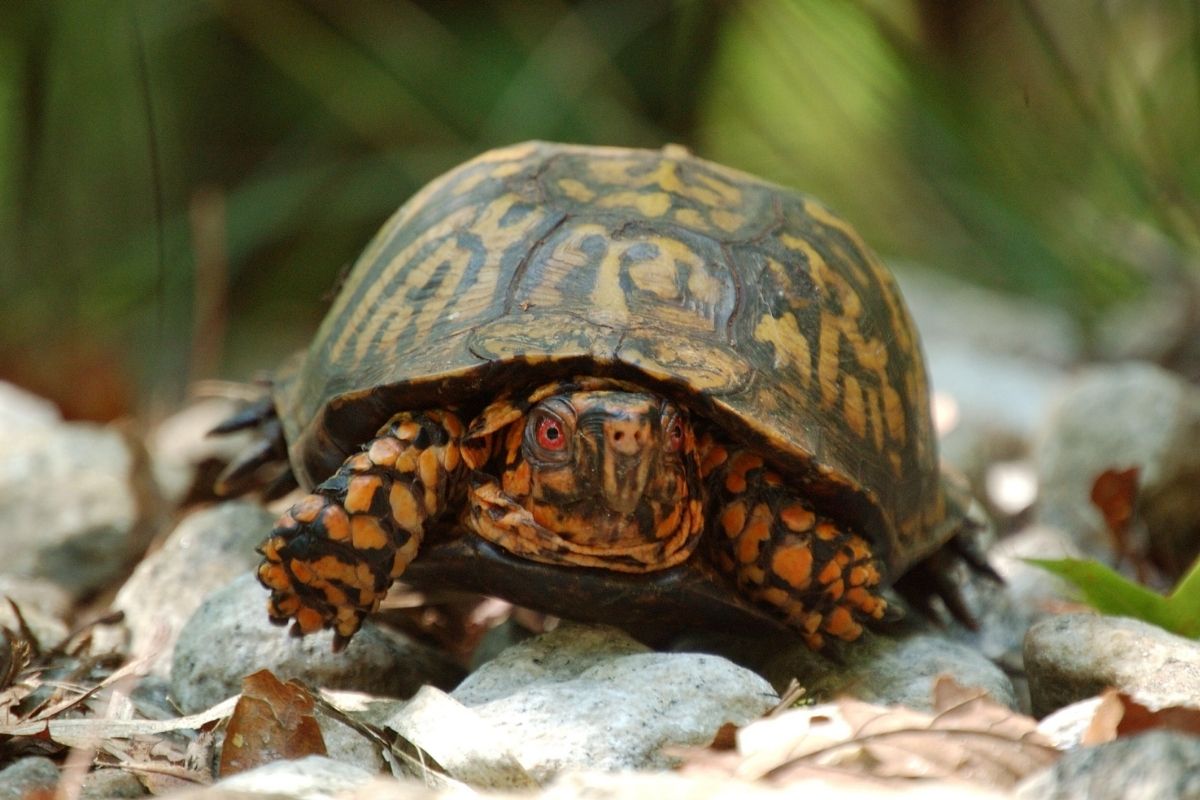
The eastern mud turtle is one of the smallest species of freshwater turtles that exist today. They barely measure over two inches in length!
These lizards are commonly found throughout the southeastern United States, especially along rivers and streams.
While many people consider them to be beautiful, they are quite ugly. Their skin is dark brown or blackish, and their shells often contain spots of different colors.
Mud turtles are omnivores, meaning that they can consume both fleshy fruits and vegetable matter as well as insect larvae and worms.
Unlike many reptiles, they do not possess teeth; instead, they rely on their trademark strong jaws and beaks to capture their prey.
Mud turtles are very territorial creatures and will attack any type of predator that comes near their territory and will often secrete a foul-smelling odor.
If you happen to come across an Eastern Mud turtle, to avoid such attacks, you need to keep yourself and your pet away from these turtles’ nesting areas.
Since mud turtles are cold-blooded, it’s essential to make sure that their temperatures remain above 80 degrees Fahrenheit. It is also crucial to ensure that they have fresh water available at all times.
Mud turtles require lots of vegetation to thrive, and if you don’t give them enough of this kind of material, they may become stressed.
If you want to take care of your mud turtle properly, you should feed them with a variety of fresh foods, such as fruit, vegetables, and even some meat.
It’s also advisable to provide them with plenty of sunlight so that they can bask and grow healthy.
Spiny Softshell Turtle

A very unique species on this list, the Spiny Softshell turtle is a species that is found across the United States, but more specifically, in the wild on the eastern side of the country, including in North Carolina.
These little guys are very unique amongst turtle species, especially freshwater ones, as they don’t have the same hard carapace and shell that turtles are best known for.
Instead, their back is covered in a layer of relatively soft scales that feel almost leathery to the touch.
Whilst this means that this turtle is less resilient in the face of physical punishment compared to other turtles, it does make it a better and faster swimmer than many other species.
Softshell turtles are native to America and are particularly abundant across the country.
Although they are a widespread species, their population has been declining significantly since the 1970s due to habitat destruction and pollution.
This makes it incredibly important that you provide your turtles with clean, unpolluted waters.
To look after your softshell turtle, ensure that they have plenty of room to move, and make sure that you provide them with fresh food regularly, such as vegetables, fruit, and even insects.
You should try to avoid feeding them anything too abrasive, as this could damage their delicate stomach lining, which would ultimately affect their overall health.
Striped Mud Turtle
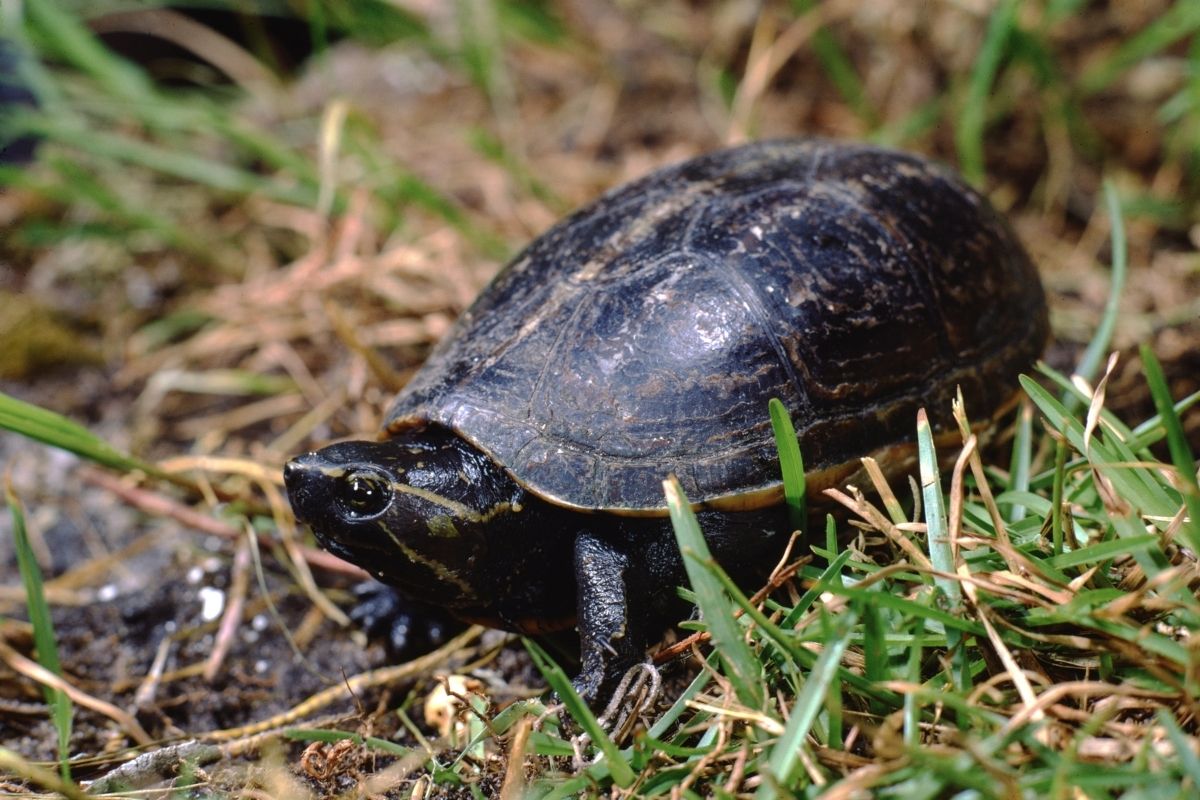
The Striped Mud Turtle is another smaller turtle species that are found across the country.
Found mainly on the Eastern side of North Carolina, this is a very popular turtle that is often kept as a pet, not just in the US but around the world!
When it comes to the Striped Mud Turtle, two main kinds are available; the American Turtle and the Louisiana Turtle. The American Turtle is usually the most common version, whereas the Louisiana Turtle tends to be rare.
The Striped Mud Turtle is often quite friendly towards humans, especially when they’re young, although they tend to get increasingly aggressive as they age.
There are many different ways that people like to keep these turtles, and this particular species is legal to keep as a pet in North Carolina.
Unfortunately, it’s not easy to own a Striped Mud Turtle as a pet, however, and there are certain precautions that you must consider before doing so.
You must remember to provide your turtle with plenty of space and ensure that they have access to water every day and food at least twice per week.
If you do keep your Striped Mud Turtle as a pet, make sure that you give them proper attention and love, and always ensure that you aren’t putting any undue stress on them or causing them to suffer from any type of abuse.
If your Striped Mud Turtle starts acting strangely, then it might be time to find out what’s wrong and seek help.
Common Musk Turtle
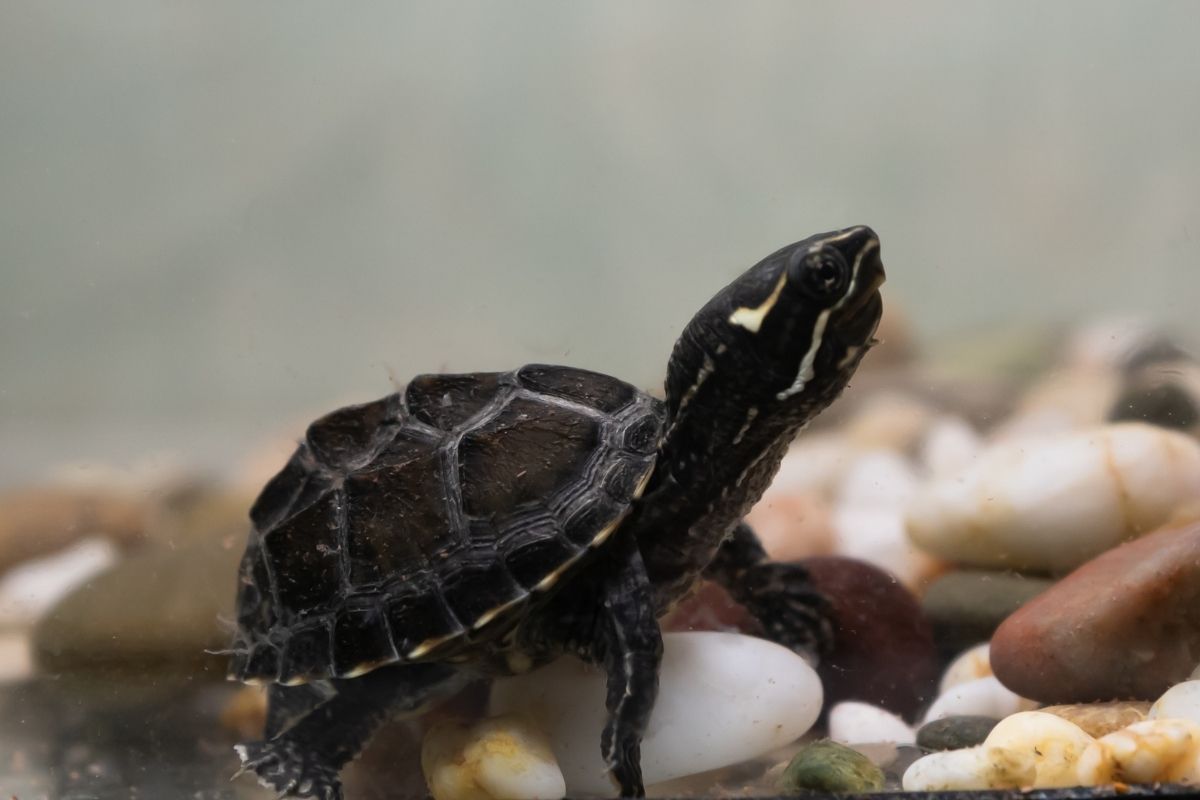
Another popular pet reptile, the common Musk turtle, is one of the most widespread small turtle species across the world and can be found across the many waterways and lakes of North Carolina.
The common musk turtle is best known for the defense mechanism it uses to deter predators and intruders to its territory, where it will secrete a terrible-smelling odor that forces animals to reconsider trying to eat them.
Whilst other species of turtles have been known to be able to do this, such as the various mud turtles species on this list, it is most often seen in this species, hence the names it has been given, both as the musk turtle, as well as ‘the stinkpot’ turtle.
Unfortunately, due to its usual temperament and awful odor-creating abilities, the common musk turtle can be difficult to keep as a pet.
You need to make sure that you take great care of them and don’t subject them to any form of stress if you want them to feel healthy and safe, as well as to not keep secreting bad-smelling odors!
It is also important to make sure that you only feed them healthy food and never allow them to consume any kind of toxic substances.
The common musk turtle needs plenty of space, so make sure that you provide enough for them to live comfortably within.
If you are interested in having a common musk turtle, then you’ll want to go through a lot of preparation beforehand, such as having the right sized tank for them (usually over 40 gallons), as well as keeping them nourished with the right food, such as small fish, insects, turtle pellets, and even some leafy green vegetables.
Striped-Necked Musk Turtle
Similar to the last turtle we talked about on this list, we have the Striped-Neck Musk Turtle.
Much rarer than their common cousins, this species is usually only found in the most western counties of the state and is a great lover of the mountain rivers and streams that run down this part of the country.
As with their common cousin, these turtles need to be kept in a large aquarium, but one that still provides plenty of room for them to move around freely. They like lots of plants and vegetation and are easy to care for.
While there isn’t much specific information available regarding these turtles, we do know that they are quite large, growing up to around 1 foot long, making them among the largest freshwater turtles found in the US.
These turtles tend to prefer more humid environments, which is why they’re so hard to come by, although they do also live alongside a few different types of freshwater fish species that they can swim near, including carp, catfish, bass, bream, eels, minnows, and others.
Their diet consists mainly of snails, worms, crayfish, leeches, insect larvae, and aquatic vegetation.
As with any animal that’s rarely seen in captivity, these turtles aren’t very popular pets, but they’re worth studying if you find yourself interested in learning more information about these amazing creatures.
That said, they do enjoy swimming around the river and lake areas that they reside in and do get along well with humans once you know how to handle them properly.
However, it is worth keeping in mind that they are illegal to own as pets in North Carolina due to their rarity and protected nature, meaning that there will likely be legal consequences to owning them, at least without proper certification.
Yellow-Bellied Slider
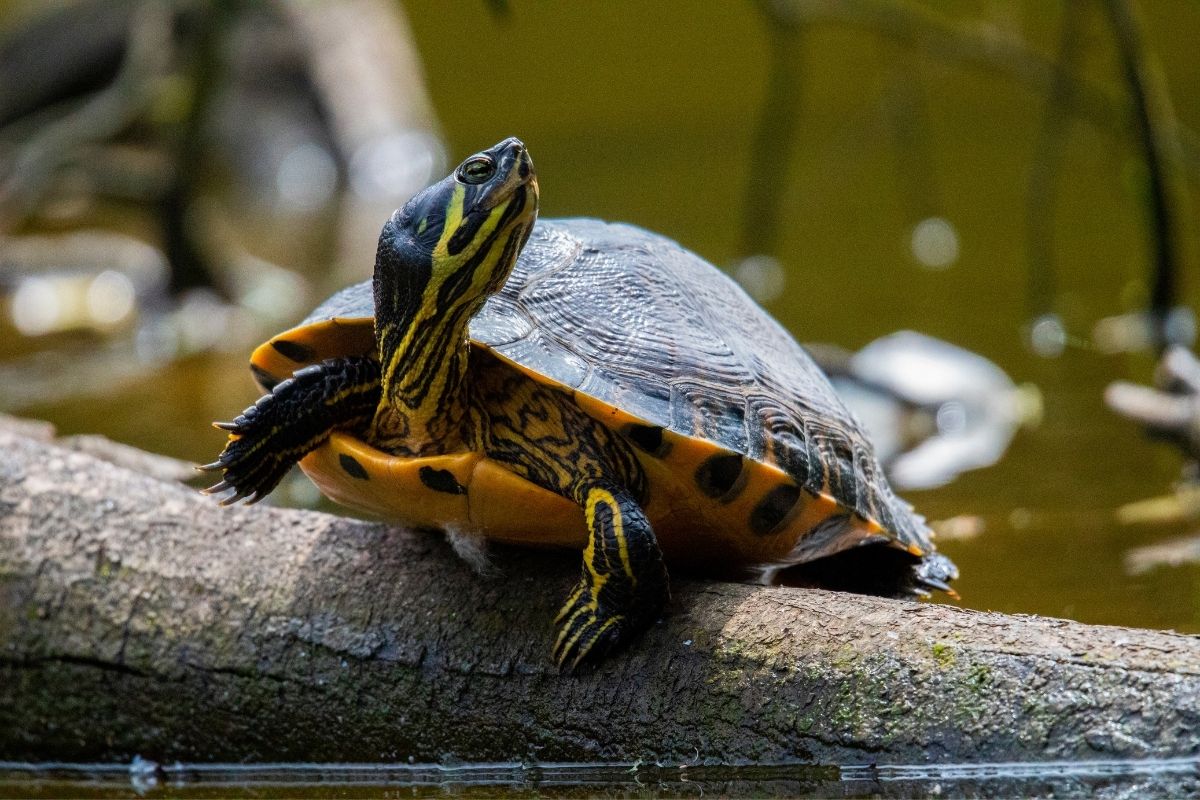
The Yellow-Bellied Sliders are easily identifiable, as they possess striking yellow bellies, as well as black heads and necks, and white bellies, alongside the many light lines that adorn their heads and necks.
This makes them stand out from other turtles, as they typically grow about a foot long in the biggest cases and weigh anywhere between 5 to 9 pounds.
These turtles are native to the southeastern United States, as well as North Carolina.
They are often considered semi-aquatic, as they sometimes venture into the water, spending time swimming and looking for prey in the shallower parts of lakes and ponds.
Most of the time, though, they spend all day basking under trees or shrubs, where they can often be spotted sunning themselves.
They do not hibernate during the winter months, instead opting to just hang out inside the cooler temperatures of the deep shade of the treetops until spring begins to arrive again.
Once outdoors, they take advantage of the warmer weather to search out new places to bask and rest. In the wild, they eat mostly insects, such as grasshoppers, beetles, caterpillars, and moths.
In the wild, these turtles mate in late summer and early fall, after the breeding season has begun, but can also reproduce year-round.
However, it is important to note that the young hatchlings tend to stay away from the water for a while after hatching, not wanting to join the adults in the cool pools and lakes.
The babies then begin to swim around and make their way toward the warmer waters, beginning to feed on algae and plankton during this time.
Spotted Turtle
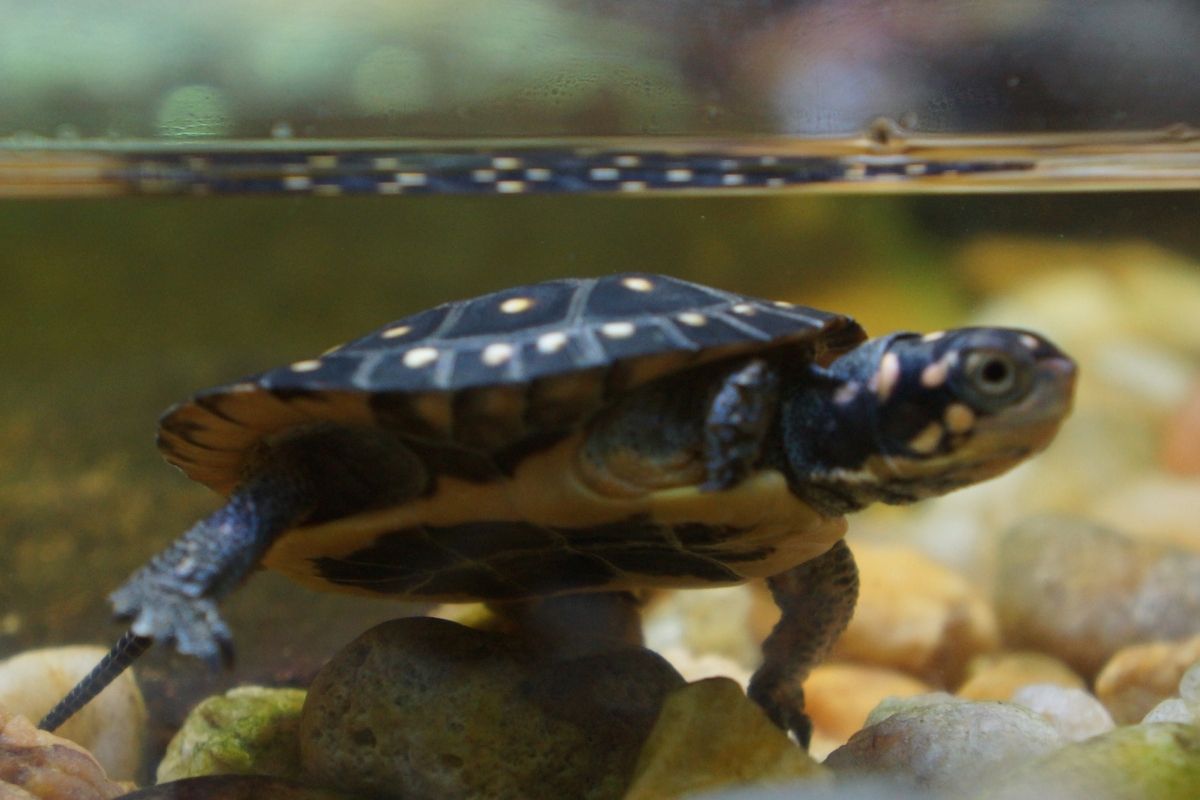
Spotted little turtles with black shells and yellow to red spots, this is probably one of the most popular and numerous species out there.
Found across the Eastern United States, this turtle is, unsurprisingly, best known for its polka-dot patterned shell and heads.
These turtles can range from 3.5 inches to 4.7 inches by the time they reach adulthood. They can live up to 20 years in the wild, although some animals in captivity have been known to live as long as fifty years in some cases!
They have no problem living away from the water for short periods and enjoy basking in the warm rays of sun on shorelines and fallen logs, although they do still spend much of their life in the waters of the rivers and streams they live in.
They are omnivorous, meaning that they eat both plant and animal food sources, including insects, fish, plants, crustaceans, mollusks, amphibians, birds, and even small mammals like mice if they can catch them!
The female may choose to lay more than one clutch of eggs over several days once she has mated, as she lays anywhere between 15 and 25 eggs at a time.
She will protect her eggs, surrounding them with gravel and soil, which helps keep the eggs safe and warm. However, she doesn’t guard them too closely as she leaves the eggs alone before the babies hatch from their eggs.
Kemp Ridley’s Sea Turtle
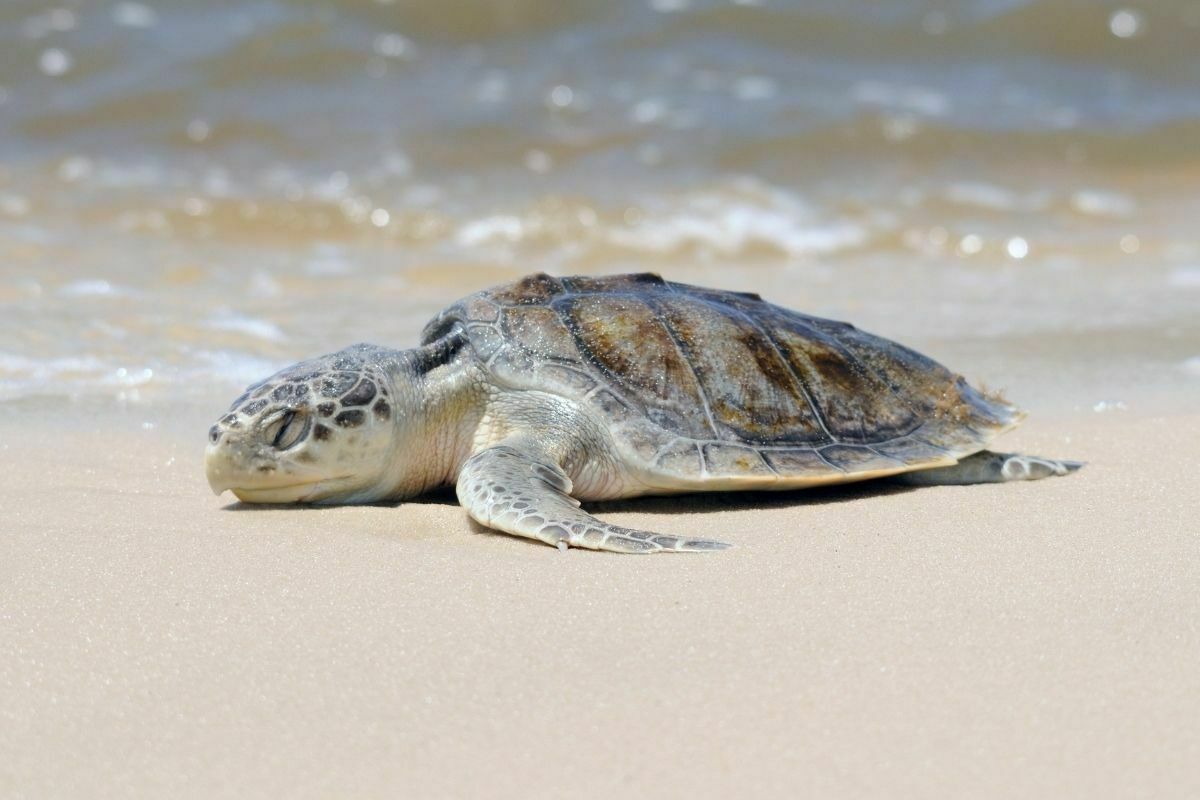
Also known as the Atlantic sea turtle, Kemp’s Ridley is found along the coast of eastern North America, from Canada down to South Florida, as well as in North Carolina and throughout the Caribbean Islands.
This particular species is native to the Gulf of Mexico, so it is not a native species.
This is a slow-growing turtle, taking about 30 years to reach full maturity. Unlike other turtles, this species does not hibernate in the cold months of winter, instead choosing to remain active and continue feeding on the rich foods available near the ocean.
They eat primarily jellyfish and shrimp and can grow up to 75 centimeters in length. This is primarily a shallow-water turtle, preferring to stay in warmer water around the tropics.
They stay relatively close to the surface at depths of around 50 meters, although they have been known to dive to depths of over 400 meters when the situation calls for it.
They are also one of the most endangered species of turtle that we are aware of, with pollution and habitat loss being some of the biggest reasons for their decline in recent years.
Green Sea Turtle
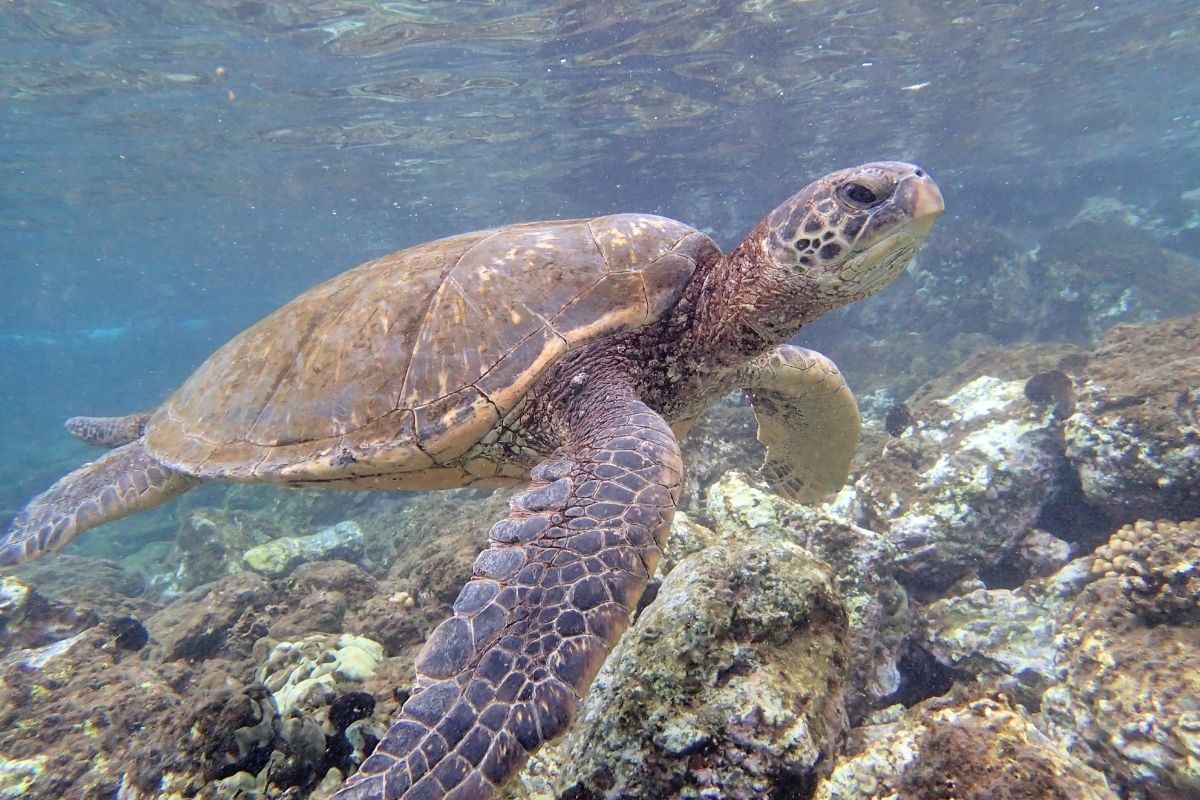
For the first official sea turtle on this list, we have the Green Sea turtle.
Whilst this species of ocean animal swims and lives across the world and nests and lands in many others, North Carolina is lucky enough to have the right coastlines and coastal groves to allow this large species of turtle to live and lay eggs here.
It is the largest aquatic reptile in the world, reaching lengths of over 5 feet and weighing around 400 lbs in some cases.
Some examples get even bigger than this, however, with some weighing more than 500 lbs and growing up to 6 feet in some extreme cases!
Sea turtles spend most of their lives in the oceans of the world and come ashore only to nest and lay their eggs.
Their name comes from the green coloration of their skin, which changes to turquoise blue once the eggs are laid, and then turns red once the eggs hatch.
They feed mostly on jellyfish, crabs, prawns, shrimp, clams, and other prey items in the shallow waters where they normally lay their eggs.
However, they also eat seaweed and vegetation when needed and can breathe air when necessary while at sea.
Loggerhead Sea Turtle
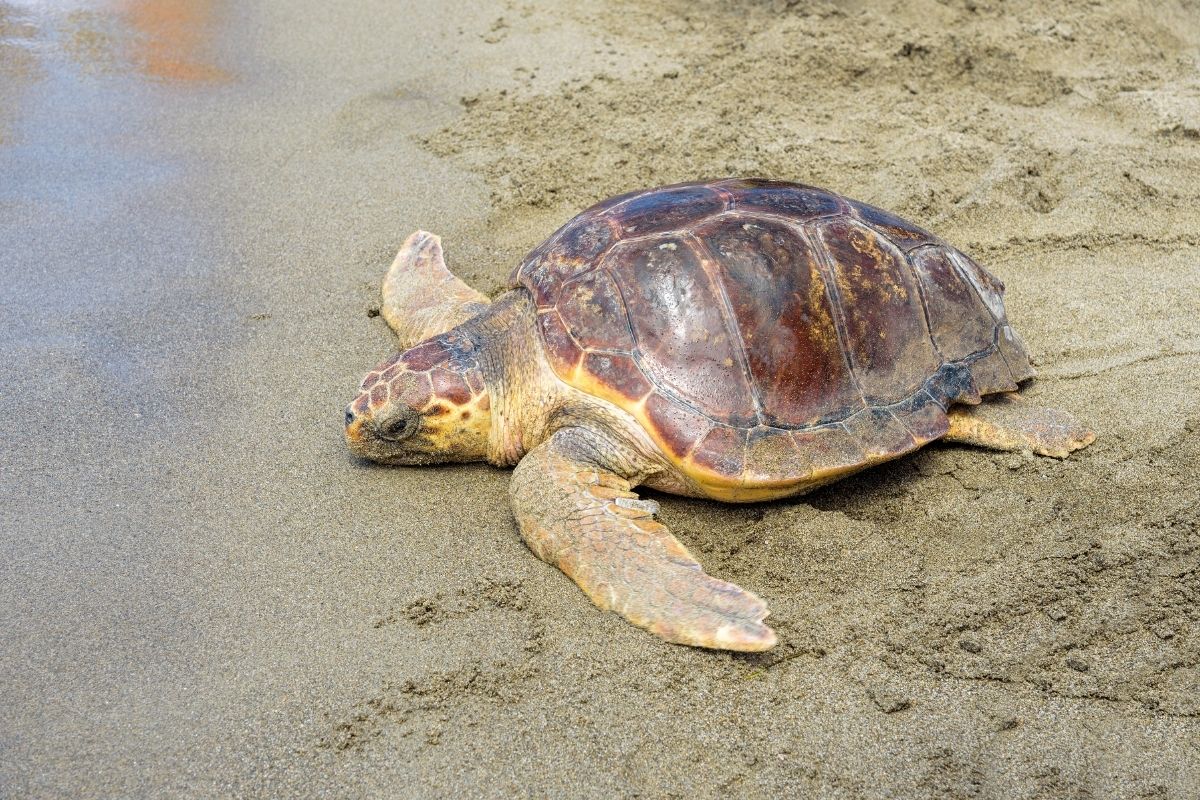
For our second species of sea turtle, we have the Loggerhead Sea turtle. These are the most commonly seen of all the species of sea turtles, not just in North Carolina but across the globe.
When they reach adulthood, these leatherback and loggerhead sea turtles are considered “oceanic” because they spend most of their lives swimming and living in the open ocean.
They have been known to stay out for months at a time without coming onto land, diving deep under the surface of the waves.
However, when they need to rest or go ashore to lay their eggs, they make their way toward the shoreline and choose areas like marshes or beaches to lay their eggs and create their nests.
Unlike other turtles who typically bury their eggs underground, the mother sea turtle covers hers with sand and sticks and then leaves her nest alone until she has finished laying her eggs.
After covering them, she digs out a hole nearby and returns to the ocean.
Once the young turtle hatches from its eggs, it will crawl away from the nest and begin its life as an independent animal.
Leatherback Sea Turtle
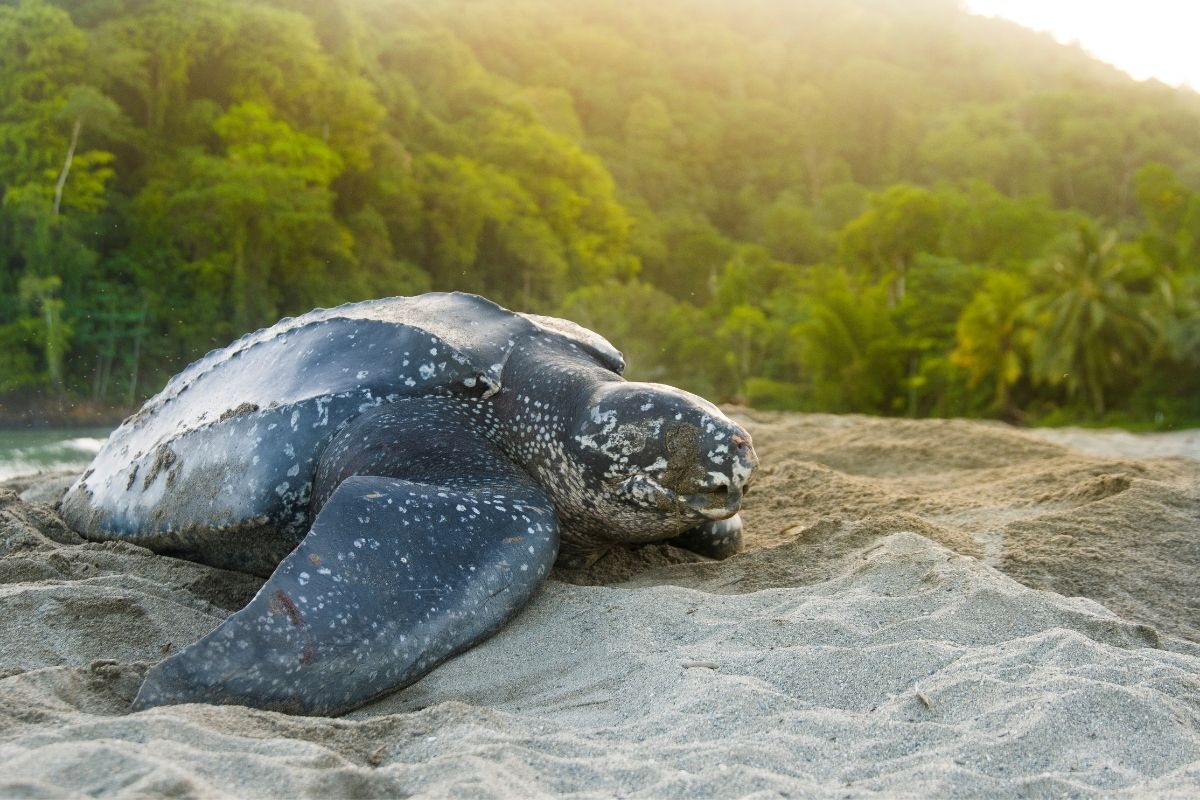
One of the largest species of turtle in the world, the Leatherback Sea turtle has several nesting sites and coastlines that it calls home in North Carolina.
These enormous reptiles get their names from the comparatively soft shell and carapace they have, at least when compared to other turtles.
The texture is often compared to leather, very similar to the Spiny Softshell turtle we talked about before.
Only this turtle gets bigger. Much bigger.
These are massive animals. At over 2 and a half tons in some cases and growing to a length of 7-8 feet, these rank among some of the heaviest reptiles in the world. Only a select few species of crocodiles can claim to be any larger or heavier!
Although they do spend most of their lives at sea, they do visit some coasts during their lifetime to lay their eggs.
When they are ready to breed, often after 10 years or so, they will head off to one of the many beaches and coastal regions in North Carolina that they feel comfortable with and use special rock formations as a place to leave their eggs behind.
They usually dig holes between 4 and 8 inches wide and 20 inches long and cover them with layers of sand and shells.
Once they finish covering their eggs with the sand and shells, they start digging again to create a new nesting area nearby.
After several weeks, the baby sea turtles hatch from their eggs and begin making their way to the water.
Once there, they continue to grow and develop over the next 10 years of their life, starting the cycle all over again.
Frequently Asked Questions
What Is The Most Common Terrestrial Turtle In North Carolina?
The Eastern box turtle takes the title of the most common terrestrial turtle in the state of North Carolina and, indeed, the entire eastern United States.
What Do North Carolina Turtles Eat?
As we touched upon earlier, the diet of a turtle depends on its species and habitat.
Many turtles are herbivores, meaning they only eat plants, but there are also quite a few omnivore turtles in North Carolina, meaning they eat a combination of plants and animals.
Do Turtles Hibernate In North Carolina?
Believe it or not, turtles don’t actually hibernate. They engage in something known as brumation, which is similar but not quite the same.
Brumation involves the slowing down of the metabolism to help the turtle survive without food or water, but they will stir eventually in order to have a light snack and slurp some fresh H2O to keep them going.
Conclusion
As you can see, when it comes to turtles, North Carolina has them in spades. There are dozens of different types of turtles that are native to this state or call it their home, and each type has unique habitats that they prefer.
Hopefully, this article sheds light on which ones you might see while visiting these beautiful coastlines and the best places to find them.
